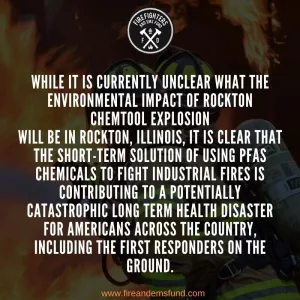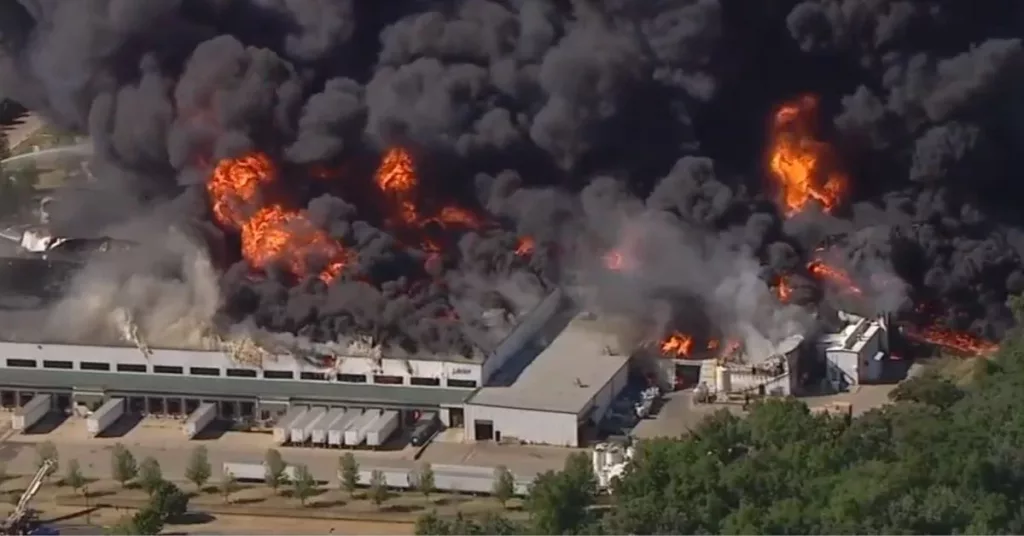In the early morning hours of June 14th, a massive explosion took place within a Chemtool factory located in Rockton, Illinois.
It would take two weeks for an investigation of the fire to be completed, with officials ultimately concluding that the fire was accidental.`
On June 25th, NBC 5 Chicago reported:
“Officials said a scissor lift involved in the replacement of insulation on an elevated heat transfer piping network at the Chemtool lubricant production plant, located at 1165 Prairie Hill Road, likely struck a valve or piece of piping “with sufficient mechanical force to cause the release of mineral oil.”
“That morning, an employee of an outside contractor performing the insulation replacement project was working in the area of origin,” Rockton Fire Chief Kirk Wilson said in a statement. “They were utilizing a scissor lift to access the elevated heat transfer piping network.”“
What caused the ignition at the factory has yet to be determined.
While no one was directly injured in the fire, the days-long operation to contain and extinguish it, in which over 80 separate fire departments participated, resulted in local evacuations and a host of environmental concerns, NBC 5 reported.

CBS Local Chicago reported on July 13th that surveys of the area did not find any evidence of local air and water contamination, but investigations will continue throughout the cleanup effort.
But one long term concern for both local residents and the firefighters called in to battle the fire is the potential use of “forever” PFAS chemicals used by one private firefighting company hired to participate in extinguishing the fire by Chemtool.
On June 17th, MSN reported remarks made by local officials at the Illinois Environmental Protection Agency concerning the likely use of these carcinogenic chemicals in the containment of the fire:
“While there is no indication that the fire itself impacted the river, a Chemtool contractor used a fluorinated firefighting foam to put out the fire that may contain chemicals of concern,” a spokesperson for the agency said in an email. “The company has since switched to using non-fluorine foam and with preventative efforts to keep foam from reaching the water, visual inspections do not indicate any impacts to Rock River at this time.”
The US Fire Administration notes the dangers of these chemicals, including links to certain cancers:
“Certain PFAS can accumulate and stay in the human body for long periods of time. Long-term exposure to PFAS/PFOA/PFOS, in high concentrations, causes a buildup in the body. This buildup may have negative health effects like a risk of thyroid disease and testicular, kidney and bladder cancers.“
These chemicals are largely unregulated by the EPA, and some scientists are now warning that they represent a “ticking time bomb” in our nation’s water supplies, according to Yahoo News:
“Some level of PFAS, widely known as “forever chemicals” because they do not break down in the environment, have been found in water samples of 2,790 communities across 49 states, according to an analysis by the Environmental Working Group (EWG), an independent research and consumer watchdog organization pushing to limit exposure to chemicals through water, food and household products.“
While it is currently unclear what the environmental impact of this incident will be in Rockton, Illinois, it is clear that the short-term solution of using these foams to fight industrial fires is contributing to a potentially catastrophic long term health disaster for Americans across the country, including the first responders on the ground. The use of PFAS chemicals in industrial firefighting must be curbed for the long-term health of American firefighters and for the health of the communities they serve. Now that the data continues to suggest the benefit of these agents do not justify the cost, it is imperative that the health of our firefighters be put first.
Image Credit: Video screenshot from https://abc7chicago.com/rockton-il-chemical-plant-explosion-chemtool-fire/10788212/
Firefighters have a 9 percent higher risk of being diagnosed with cancer and a 14 percent higher risk of dying from cancer than the general U.S. population. For some reason, most states have yet to establish cancer funds for firefighters. Finally, two states have taken action to change that.









